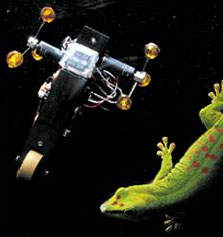A cockroach-like robot named RHex (more pictures, video and information) is the starting point for a major project to understand how animals move without falling over, as robots can serve as a controlled experiment that’s easier to manipulate than real animals but able to tackle real-world challenges.
![moving_sequence[1].jpg](http://www.we-make-money-not-art.com/xxx/moving_sequence%5B1%5D.jpg)
Biologists, engineers and mathematicians from universities across the USA will try to understand the mechanical and neurological basis of locomotion.
RHex, a six-legged robot that scampers like a cockroach, will be tweaked and used it as a physical model to tease apart the complex neural and muscular networks in insects.
At the same time, they will conduct biomechanical and neurological experiments on insects and develop mathematical models to improve the robot.
Robert Full, professor of integrative biology at UC Berkeley and leader of the team, has studied animal locomotion for 30 years, and has contributed to other robots too:
– Ariel, which walks like a crab and was designed to detect underwater mines;
![ariel_horiz[1].jpg](http://www.we-make-money-not-art.com/xxx/ariel_horiz%5B1%5D.jpg)
– Mecho-Gecko, a three legs robot with a pressure-sensitive adhesive (think Post-Its) to mimic the unroll-and-peel-off manner in which geckos climb up walls;

– and the Sprawlita, which bounces five body lengths at a time thanks to six piston-driven legs.
![sprawlita_3[1].jpg](http://www.we-make-money-not-art.com/xxx/sprawlita_3%5B1%5D.jpg)
From Medical News Today, via Robotics.
See also Robopike (inspired by pikes), A robot that walks on water (imitates water skimmers), Ecobotil (the one that eats flies), The roachbot (real cockroach controlling a robot), Smaller, smarter and higher (fly-like robot), Locusts’ navigational skills (a locust-inspired, collision-avoiding robot) and Lemur (climbing robot.)
